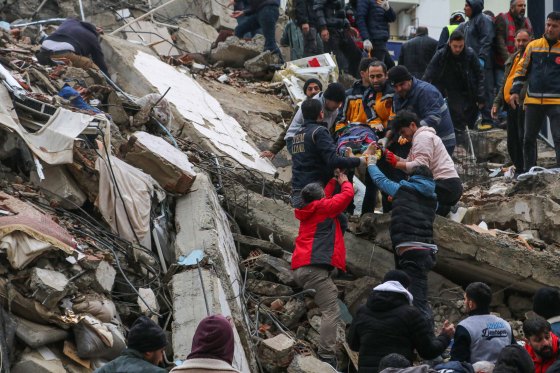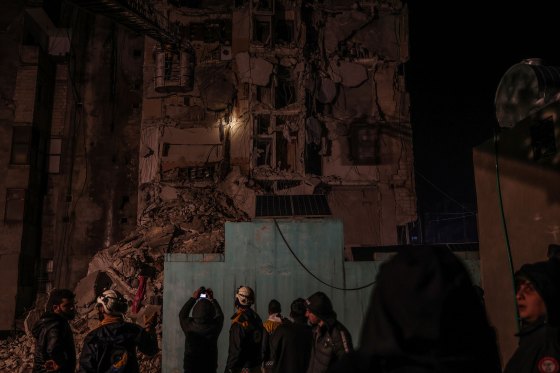When a 7.8 magnitude earthquake struck southeastern Turkey and northwestern Syria early Monday morning local time, its tremor could be felt as far afield as Lebanon, Cyprus, Greece, Israel, and the Palestinian territories. A second quake, which recorded a magnitude of 7.5, struck just 9 hours later.
Both countries are still reeling from the devastating aftermath. So far, at least 2,300 people have been killed as a result of the quakes, and thousands more have been injured. Thousands of buildings have been reduced to rubble.
Though earthquakes are not uncommon in this part of the world, today’s is believed to be the largest and deadliest one to hit Turkey in decades. Here’s what we know about it.
[time-brightcove not-tgx=”true”]
When and where did the earthquakes in Turkey and Syria occur?
The initial earthquake struck the southern Turkish city of Gaziantep, roughly 150 miles away from the Turkey-Syria border, at 4:17 a.m. local time at a depth of about 11 miles, according to the U.S. Geological Survey. The second earthquake, the epicenter of which was roughly 80 miles north of Gaziantep in Turkey’s Kahramanmaras province, struck at 1:24 p.m. local time and was six miles deep, according to USGS.
At least 120 aftershocks have taken place in southern Turkey, according to the country’s Disaster and Emergency Management Agency (AFAD).

IHA agency/APPeople and emergency teams rescue a person on a stretcher from a collapsed building in Adana, Turkey, on Feb. 6, 2023. A powerful quake has knocked down multiple buildings in southeast Turkey and Syria and many casualties are feared.
How big is a 7.8 quake on the local magnitude scale?
While an earthquake magnitude of 2.5 or less can pass by undetected, earthquakes with a magnitude of 7.0 or higher are classified as a “major earthquake,” which can cause serious damage. A magnitude 8.0 or higher, considered “a great earthquake,” is capable of destroying entire communities.
While the magnitude of an earthquake denotes its size and strength, the potential damage caused by a quake is also determined by its depth (the shallower the quake, the more damaging) and its proximity to population centers.
In a tweet, U.S. Geological Survey seismologist Susan Hough likened the size of the initial earthquake in Turkey to San Francisco’s Great Earthquake of 1906, which left more than 3,000 dead and much of the city in ruins.
Are Turkey and Syria prone to earthquakes?
Earthquakes are not uncommon in Turkey. Most of the country is situated on the Anatolian Plate, which borders two major fault lines: the North Anatolian fault, which stretches across the country from west to east, and the East Anatolian fault, which is in eastern Turkey. The former has been the site of several disastrous earthquakes, according to the Geological Society of London, including the 1939 earthquake in northeastern Turkey that resulted in the deaths of 30,000 people.
The initial 7.8 magnitude earthquake is believed to have occurred on either the East Anatolian fault zone or the Dead Sea transform fault zone, according to the USGS.

Anas Alkharboutli—picture-alliance/dpa/APSyrian civilians and members of the White Helmets work to save people trapped beneath a destroyed building following a magnitude 7.8 earthquake that hit Syria, on Feb. 6 2023.
What is the scale of the damage?
The death toll has been staggering and has surpassed 2,300 people—figures that are almost certain to rise as search and rescue efforts continue. The death toll in Turkey stands at 1,541, according to Vice President Fuat Oktay, and 9,733 people have been injured in the country. The death toll in Syria is 820, with 430 deaths reported by the Syrian Arab News Agency in government controlled areas. The White Helmets have reported 390 deaths in opposition-controlled areas.
While the full scale of the infrastructure damage is yet to be fully known, the initial assessment has been devastating. In Turkey alone, nearly 3,000 buildings have collapsed, according to President Recep Tayyip Erdoğan. One airport runway serving the southern part of the country tore open.
How has the international community responded to the earthquakes?
Erdoğan confirmed that in addition to NATO and the European Union, 45 countries have reached out to Ankara with offers of assistance, including the United States, Britain , Israel, and even war-torn Ukraine.
Turkey has sent a formal request to NATO and allies for assistance in dealing with the quakes.
Cyprus has also offered to send help to Turkey—a rare step from a country that Ankara has not recognized.
On Monday, U.S. Secretary of State Antony Blinken said, “Our initial assistance response to Türkiye is already underway, and U.S.-supported humanitarian organizations in Syria are responding to the earthquakes’ effects across the country. We are determined to do all that we can to help those affected by these earthquakes in the days, weeks, and months ahead.”
The E.U. will convene a crisis meeting Monday night to coordinate the bloc’s support measures. It is dispatching search-and-rescue teams and emergency mapping services.
The U.N. General Assembly in New York held a minute of silence today for the victims of the quakes.

